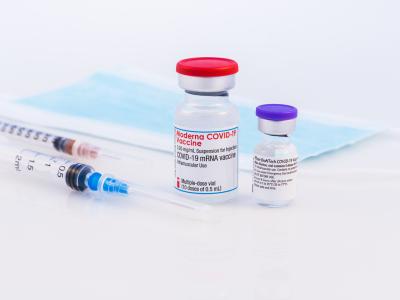Our weekly wrap-up of antimicrobial stewardship & antimicrobial resistance scans
Analysis shows US antibiotic use still heavily tilted toward livestock
A comparison of antibiotic sales data by members of the Natural Resources Defense Council (NRDC) and the Center for Disease Dynamics, Economics & Policy (CDDEP) shows that cattle and swine on US farms consume 44% more of medically important antibiotics than do humans.
Using 2018 Food and Drug Administration data on sales of antibiotics for food-producing animals and 2017 data on sales of antibiotics for use in humans obtained from the IQVIA pharmaceutical database by CDDEP, the analysis found that 65% of medically important antibiotics are being used in food-producing species in the United States, compared with 35% in humans. Cattle and swine together consume roughly 10.8 million pounds of active antibiotic ingredient, while humans consume 7.5 million pounds.
"Even taking into account a large decline from 2015 to 2017, antibiotic sales for use in food-producing animals continue to exceed sales of those same drugs for human medicine by a large margin," authors David Wallinga, MD, and Avinash Kar, JD, of NRDC and Eili Klein, MD, of CDDEP wrote in a blog post on the NRDC website. "Worryingly, those sales rose again in 2018, suggesting that previous declines may only have been temporary."
The authors said that comparable and integrated analyses covering both sales and use of medically important antibiotics—something that's not currently provided by the US government—are urgently needed.
"It's urgent that the leadership of U.S. federal agencies, as well as in Congress, work harder to protect our future by protecting our antibiotics. Providing the public each year with side-by-side comparisons of the use of these precious medicines in human medicine and in food-producing animals, is an important step," they wrote.
They also recommend that livestock producers be required to report annually on their on-farm use of antibiotics, and that the federal government set national targets for reducing medically important antibiotic use in livestock.
Jun 15 NRDC blog post
Wording change tied to fewer unneeded antibiotics for neonatal sepsis
Originally published by CIDRAP News Jun 17
A change in the wording of antibiotic duration orders for neonatal sepsis led to a substantial decrease in the number of infants who received extra unnecessary antibiotic orders, pharmacists at a hospital in British Columbia reported today in the American Journal of Infection Control.
The intervention implemented at Surrey Memorial Hospital in British Columbia in April 2016 involved a change in the way that clinicians wrote the orders for antibiotic duration in infants with sepsis, from "antibiotics for 48h if blood culture negative" to "antibiotics for 48h unless blood culture positive."
The change in the wording allowed infants to stop receiving antibiotics after they received 48 hours of therapy if the healthcare team had not received notification of a positive culture. The change was made because delays in receiving notification of a negative blood culture can lead to infants receiving extra, unnecessary antibiotic doses.
A medical review of 523 charts (268 prior to the change and 255 after the change) found that unnecessary antibiotic orders (doses beyond 48 hours) were administered to 50% (82 of 164) of infants prior the change and only 7.2% (12/167) after the change. None of the patients included in the review had a blood culture come back positive after the 48 hours of antibiotics were completed. Reductions in pharmacy time and medication waste were also observed.
"The wording and interpretation of antibiotic duration orders, as well as fostering the desired culture shift amongst staff, should be considered as strategies to reduce unnecessary antibiotic administration," the authors of the study wrote.
Jun 17 Am J Infect Control abstract
CARB-X funds rapid test for resistant urinary tract infections
Originally published by CIDRAP News Jun 17
CARB-X today announced that it is awarding India-based Module Innovations a contract worth $702,000 and up to $2.5 million more if it meets certain milestones to develop a rapid diagnostic test for drug-resistant urinary tract infections (UTIs). In a press release, CARB-X said the test would also provide information on which antibiotics would be most useful against the resistant organisms, including common ones such as Escherichia coli, Klebsiella, Pseudomonas aeruginosa, and Enterococci faecalis.
The test has the capacity to take days off the time needed to diagnose a UTI and can detect an infection and provide an antibiotic-resistance profile of the pathogen in about 2 hours. The current process requires advanced microbiology laboratories and personnel, and doctors often prescribe patients broad-spectrum antibiotics while waiting days for a test result. The approach doesn't often work, leading to sepsis, kidney damage, and other complications. CARB-X said the affordable and data-driven approach will be useful, especially in middle- and low-income countries.
Erin Duffy, PhD, chief of research and development at CARB-X, said, "This technology, if successful, could provide health professionals with fast, accurate, and affordable AST [antibiotic susceptibility testing] information for UTIs, accelerating the delivery of effective therapeutics to patients, saving lives, and reducing the risk of contributing to drug resistance."
Since its launch in 2016, CARB-X (the Combating Antibiotic Resistant Bacteria Biopharmaceutical Accelerator) has awarded more than $232.1 million to companies developing new treatments and diagnostics for drug-resistant pathogens.
Jun 17 CARB-X press release













